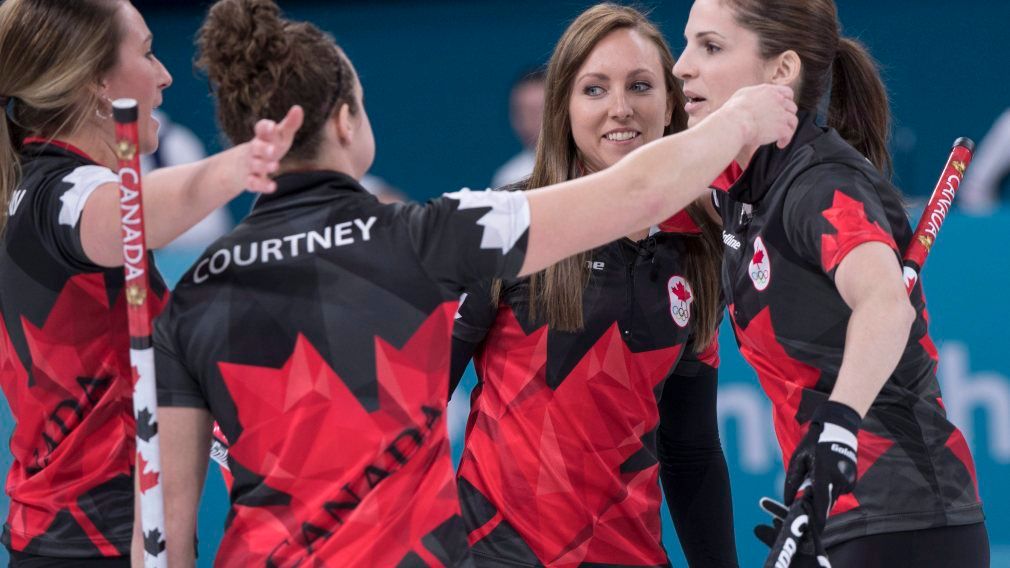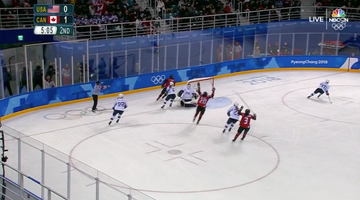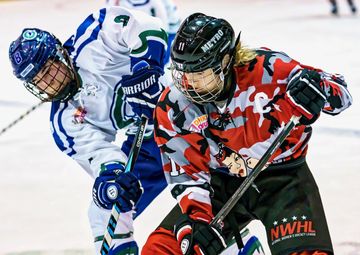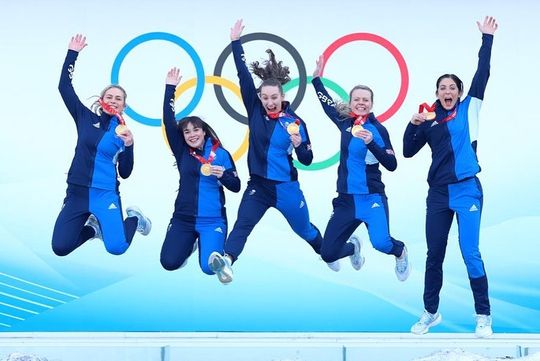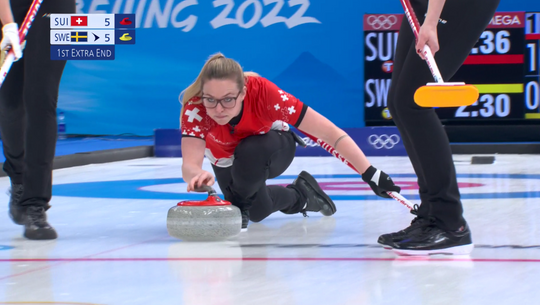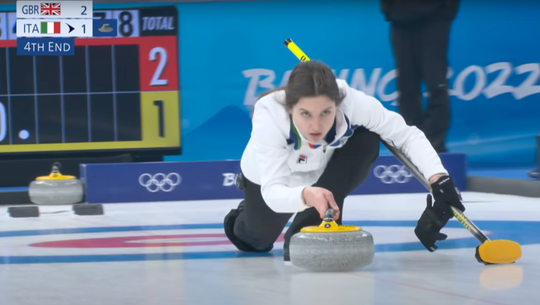The women's curling event at the Olympics is worth following for new and old fans alike. For those who have watched curling for years, names like Homan, Muirhead, and Hasselborg need no introduction and the team game is as familiar as shouts of "hard!" But for curling fans who got hooked on the game watching the exciting debut of mixed doubles curling on the Olympic stage, the traditional four-person game needs an introduction.
The biggest difference between the two games is in four-person curling there are distinct roles on each shot while in the doubles game both players are required to usually, sweep, and call line, often on the same shot. This results in curling percentages being generally higher in four-person curling as each throw has a different player to throw, brush, and call line. Doubles curling is more collaborative; generally both players determine how they will approach an end tactically while in four person curling the skip (in consultation with their vice/third) determines the approach to an end. If you liked listening in on the strategizing in doubles curling, you'll love traditional curling, where strategy is emphasized a lot more.
In traditional curling there are no prepositioned stones. Instead, the front end (the lead and the second) set up the end with their throws. The four-rock rule (which has been in place since 1993 but will change to a five-rock rule next season) means that rocks in the free guard zone (the area between the hog line and tee line, excluding the house) aren't able to be peeled and are protected until the fifth shot of an end. Unlike doubles curling, where both teams have five shots and six stones in play, each player in traditional curling throws two stones for a total of eight stones in each end. In traditional curling, teams sometimes blank to retain hammer. Blanks don't happen in mixed doubles curling because a blank results in the loss of hammer. Finally, there are ten ends in four-person curling, making for a longer game.
Through the first five games of the women's curling event the biggest story is that Team Canada, the current world champions, lost its first three games and have to run the table to make the playoffs. Team Canada -- comprised of lead Lisa Weagle, second Joanne Courtney, third and vice Emma Miskew, and skip Rachel Homan -- entered as heavy favourites and opened the tournament against the home team from Korea. Playing the home country team in your first draw is a slight disadvantage, as they have more familiarity with the facility and stones.
Canada played well enough to win; the team curled at 84% versus just 77% for Korea. But skip Kim Eun-jung and third Kim Kyeong-ae made key clutch shots throughout the game that helped Korea steal five during the game. The pair was great! But Homan also helped her opposition win. Team Canada entered the break down 4-1, but the Canadians tied it up by the seventh end. They held the Koreans to one in the eighth, but couldn't convert with hammer in nine. Faced with a draw for one or a runback with the potential to net a pair, Homan, ever aggressive, opted to go with the heavy weight to secure two points. But she missed her shot, and the Koreans stole three.
Things didn't get any easier for Team Canada in draw two when they played Anna Hasselborg's Team Sweden. Like Canada, Sweden has a rich curling tradition; the country has eight women's world titles and two women's Olympic titles. In addition, the legendary Anette Norberg, two-time Olympic champ, three-time world champion, and seven-time European champ, represented Sweden internationally for three decades. Hasselborg is a relative newcomer on the international scene at this level, having represented Sweden at last year's world. But she has European championship success and a junior world title on her resume as well.
It was a back and forth game, with the Swedes stealing two in the first and the Canadians drawing even in the third. The teams traded singles in the fourth and fifth, and crucially, Sweden got two with hammer in six. Canada stole in eight, held Sweden to one in nine, and tied it with a single point in ten to send it to extra ends. In the eleventh, Sweden managed to score one with hammer and secure victory. Homan and Miskew, 89% and 77% respectively, outcurled their Swedish opponents Hasselborg, 83%, and Sara McManus, 70%, but the Swedish front end of Sofia Mabergs and Agnes Knochenhauer had a marvelous game; Mabergs was perfect while Knochenhauer outcurled Courtney by 15%.
Down 0-2, Team Canada hadn't played badly, but also hadn't played at its highest level. Things went from bad to worse against Denmark. The Danes were blown out in their opener against Sweden 9-3 and followed that loss with another against Japan, 8-5.
With both teams 0-2, it was always going to be a tense game, but this match took a turn for the worse in the fifth end when Homan made the abrupt decision to pull a burned Danish stone. (A burned stone is a stone that has been touched by a player.) When a stone is burned, the non-offending team has the choice to remove the stone, replace all stones to where they think they would've ended up, or leave the stones as they are. Typically, the teams discuss where the stones would likely have landed and arranged them in place.
What Homan did was well within her rights according to the rules, but breached curling etiquette. It turned the end around for Team Canada and helped them score four to take the lead 6-4. One of the reasons it bothered many in the curling community is because it's likely Canada's desperation played into Homan's decision. Winless with two losses and down 4-2 in the fifth end, Homan needed a break, needed to turn things around. She took the opportunity presented by the burned stone. I have no doubt had Team Canada already banked two wins, or had they been leading in the game, Homan simply would have discussed with Danish skip Madeleine Dupont where to replace the stones. That seems to be how Dupont viewed it, who said she wouldn't have done it, and talked at length about the burned stone decision on Friday and Saturday.
In my opinion, Homan probably should have discussed placement with Dupont; however, the reaction of the curling community seems a bit disproportionate. While it affected the outcome of an end, Team Canada couldn't close out the victory, giving up two in 10 and a steal of one in the extra end for the 9-8 Danish victory. That it's still being talked about has more to do with Team Canada's status as the top ranked team in the world. It also may have to do with the public perception of Homan. Many see her negatively because she is very serious and focused on ice.
Homan and her team seem to be taking an "us against the world" mentality since the burned rock controversy and have been able to turn around their tournament. A closed-door meeting followed their morning disaster against Denmark but by that evening, Team Canada looked like world champions again when Homan's team beat Team USA 11-3. Stealing three in the first, Canada never looked back, adding three in the fifth, and putting a four on the board in the seventh, which resulted in handshakes. The trio of Courtney, Miskew, and Homan all had dominant, bounce-back performances. Courtney curled at 93%, Miskew at 98%, and Homan at 96%. As a team, the Canadians curled at 93% while the Americans curled at 72%. It was simply a dominant performance that stopped the bleeding.
Still, Team Homan wasn't out of the woods and they looked in danger of dropping their next draw against Switzerland in the fifth end. After giving up 3 in the fourth, Canada trailed 4-2 in the fifth. Canada got its deuce in five to head to the break tied, but then promptly surrendered three in six to fall behind again. But Canada had a second comeback in them, scoring 2 in seven, 3 in nine, and stealing a point in the tenth end to win, 10-8. Homan outcurled her Swiss counterpart, Silvana Tirinzoni, by 10%, 83% to 73%. Miskew, who's carried the team to this point, continued her strong play curling at 85%. Courtney had her worst game by far, curling at 58% to Swiss second Manuela Siegrist's 90%.
After five games, Canada sits a disappointing 2-3. It's not where they expected to be at this point, but it hasn't been the disaster it's been portrayed as. While Courtney has struggled a bit with her throwing, curling at 78% through five games, good for fifth among seconds, her teammates are all among the tournament leaders in curling percentage. The ever-reliable Weagle is second among leads, curling at 84%, and Homan is second among skips at 79%. There's room for improvement there, but that trio is more than capable of improving those numbers. Emma Miskew needs to keep doing what she's been doing, as she's tied with Sara McManus of Sweden for first place among thirds, curling at 85%. Canada sits fourth in point differential with +6 which can be improved on by tightening up their defensive play. Team Homan has given up 4 three-point ends; Japan, Korea, and Sweden, the three teams above Canada in point differential, have only given up 4 combined.
The surprise of the tournament so far has to be the Koreans, who followed up their upset 8-6 win over Canada to start the tournament with a 7-5 loss to Japan, before topping Switzerland 7-5, Great Britain 7-4, and blowing out China 12-5. Individually, their numbers are middle of the pack, but skip Kim EunJung has made key shots at opportune times to send Korea to the top of the standings. I would be surprised if Korea isn't playing come playoff time.
Sweden has looked like the class of the field so far, and was the only remaining undefeated team through five games. While they're no longer undefeated (losing a close one to Korea 7-6 last night), individually the team has been simply dominant. Agnes Knochenauer leads all seconds by curling at 84%. Sara McManus is tied with Miskew to lead all third with an 85%, and skip Anna Hasselborg is dominating her competition by curling at 84%.
Japan has also had a strong start to its Olympic tournament. Led by skip Satsuki Fujisawa, Japan opened the tournament with a 10-5 thrashing of Team USA, a game in which third Chinami Yoshida was especially dominant, curling at 86%. An 8-5 victory over Denmark followed, and Yoshida once again played extremely well, later curling at 88% in a 7-5 victory over Korea. Japan lost a close game to China, 7-6 in extras primarily because the Fujisawa rink couldn't hold the Chinese team to one, giving up 2 in the third and 3 in the eighth. Fujisawa and Yoshida were at their best against OAR, curling at 92% and 86% respectively and earning Japan its fourth win 10-5.
After a convincing 10-3 win over OAR in its opener, Team Great Britain has had a mixed bag in their quest to make the playoffs. Team GB followed its opener with a 7-4 loss to Team USA, an 8-7 win over China in extras, and a 7-6 win over Denmark. But a 7-4 loss to Korea in which Anna Sloan curled 66% has Great Britain feeling the heat. As usual with Team GB, some players are not playing to the standard of a medal round team. Lauren Gray is curling 81%, seventh among leads. Third Anna Sloan is struggling, curling 74% or ninth at her position.
I was curious to see how players who participated in the mixed doubles event would play in the four person tournament as the doubles event was tiring but added crucial on ice and rock-reading experience. Jenny Perret, the silver medalist from the mixed doubles event, is the alternate for Switzerland in the four-person tournament and hasn't seen action yet. Though as the alternate, her experience with the rocks might help in her role tracking stones for her teammates. So fair things look good for American Becca Hamilton, who's curling at 84% and sits third among leads. With just two wins in its first five games though, Team USA will have a hard time advancing to the medal round.
(Photo: Team Canada/Twitter)
